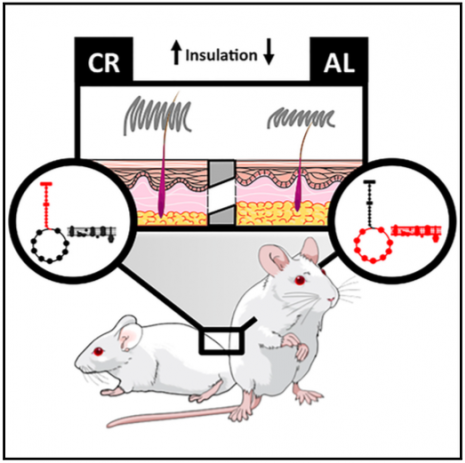By: Alicia J. Kowaltowski, M.D., Ph.D., Universidade de São Paulo
Obesity enhances the incidence and prevalence of many diseases, but is still increasing worldwide. Our group is focused on understanding mechanisms involved in the protective effects of maintaining a normal body weight, in order to uncover new targets for obesity-related diseases. We do this by studying rodents that eat ad libitum (as much as they want) and develop obesity versus animals on a calorically-restricted diet. Calorically-restricted rodents have been shown to have less oxidative damage and age-related diseases, as well as extended lifespans. 
Many of the effects of caloric restriction, predictably, involve changes in energy metabolism and mitochondria, the central hub of energy metabolism. Recently, while investigating mechanisms in which calorie restriction prevents excitotoxic neuronal death (Amigo et al., 2017), we found that mitochondria from calorically-restricted animals can take up Ca2+ ions faster and in larger quantities. The higher buffering capacity these mitochondria have promotes protection against neuronal death caused by excessive Ca2+ in the cytosol.
Because this is a completely new effect of caloric restriction, we decided to investigate if mitochondrial Ca2+ uptake was also modified in the liver (Menezes-Filho et al., 2017). We found that liver mitochondria from calorie restricted mice could also take up more Ca2+, and that this was related to protection against ischemic damage. Overall, the finding that caloric intake affects mitochondrial Ca2+ uptake is interesting because Ca2+ is a well-known modulator of energy metabolism and mitochondrial oxidant production. Based on these initial findings, we hope to uncover more connections between metabolic regulation, redox state, caloric intake and Ca2+ in futures studies.
While studying calorically-restricted mice, we noticed that they had different fur from obese ad libitum fed animals. We then decided to investigate changes in the skin and fur of calorie restricted animals, and found many modifications, both in the structure and metabolism of the skin. One interesting finding was that the fur in calorically-restricted mice has a higher insulation capacity, and is necessary for them to thrive: shaving calorie restricted animals makes them lose muscle mass. We are not sure how these results relate to humans, who aren´t very furry, but believe this is an evolutionary adaptation to deal with heat loss. Although the skin is our largest organ, it is not often studied, and there are almost no related findings. We hope that with this study and the development of methodology to monitor metabolism in the skin, more interest will arise.
Amigo I, Menezes-Filho SL, Luévano-Martínez LA, Chausse B, Kowaltowski AJ. Caloric restriction increases brain mitochondrial calcium retention capacity and protects against excitotoxicity. Aging Cell. 2017 16:73-81.
Forni MF, Peloggia J, Braga TT, Chinchilla JEO, Shinohara J, Navas CA, Camara NOS, Kowaltowski AJ. Caloric restriction promotes structural and metabolic changes in the skin. Cell Rep. 2017 20:2678-2692.
Menezes-Filho SL, Amigo I, Prado FM, Ferreira NC, Koike MK, Pinto IFD, Miyamoto S, Montero EFS, Medeiros MHG, Kowaltowski AJ. Caloric restriction protects livers from ischemia/reperfusion damage by preventing Ca2+-induced mitochondrial permeability transition. Free Radic Biol Med. 2017 110:219-227.
— Published
Category: Redox Biology